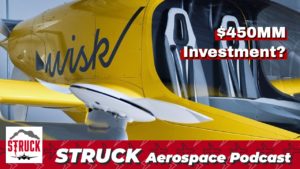Eviation prepares for test flights, and the Leonardo AW609 is back in the news–will it finally achieve certification and commercial success? Plus if a plane emergency lands in water or has its parachute deploy (in the case of Cirrus aircraft’s CAPS system) is the plane capable of returning to service? And, we discuss United making a big jet order and big push toward the top of commercial aviation.
Learn more about Weather Guard StrikeTape segmented lightning diverters and aircraft lightning protection consulting services. Follow the show on YouTube, Twitter, Linkedin and visit us on the web. Have a question we can answer on the show? Email us!
Podcast: Play in new window | Download
[TRANSCRIPT] EP61 – United’s Big Move; Flying a Waterlogged Plane? Plus, Eviation & Leonardo Tilt Rotor Aircraft
0:00
This episode is brought to you by Weather Guard Lightning Tech at Weather Guard. We support design engineers and make lightning protection easy.
0:14
You’re listening to the struck podcast. I’m Dan Blewett. I’m Allen Hall. And here on strike, we talk about everything aviation, aerospace engineering and lightning protection.
0:30
Alright, welcome back to the struck podcast. This is Episode 61. On today’s show, we’re going to chat about United Airlines making a pretty big push.
0:39
Obviously, they’ve been a big player in commercial aviation for a long time. But maybe they’re really doubling down with a big order from Boeing and some other endeavors. We’re talking about a pretty interesting space balloon that challenges what this sort of edge of the earth travel could look like. We’ll talk about planes whether they’re flyable, again after a water landing, or even the cap system deploying on a Cirrus aircraft, if there’s any chance that are ever a chance that they could be flyable. Again, lastly, on our EBT wall segment, we’ll talk about aviation Volocopter. And this tilt rotor from Leonardo, the AWS 609, which is not an EBT. Well, exactly, but really interesting and might be coming to fruition soon with certification. So, Alan, how are you sir? What’s the deal with United? Are they trying to be the I feel like they’ve always been a tertiary commercial airliner, but it seems like they’re, they’re they’re done with that image? I mean, is that how you sort of
1:38
look at them? Well, I think at the moment, there may be taking the advantage of the market conditions where airline May, while the airlines got infused with some government cash in the United States, even though the travel industry is still down the opportunity to buy your planes at a lower price, if you’re thinking about inflationary pressure, and not, particularly in United States and Europe, it may be a good time to buy an airplane and because Boeing is looking for some cash right now, and Airbus also, you may be they may have negotiated a really good deal for themselves, because you never see the published sale prices that is University published prices and sales, right? So yeah, you always see what the list price is. And they always have a disclaimer, any article you read, well, they probably paid a lot less than what the market says the value of the aircraft is, which is fascinating. Every airplane sells at a different price. It’s it’s kind of like cars, but worse. I think, really, that’s that sounds really surprising. You wouldn’t think that as a consumer, you’d think that this was very, because of just how how many costs are involved and just how much I mean God to build an airplane, it’s such a such a process and so much engineering, you think it’d be much more fixed and original, then then some Yahoo slinging cars on a used use lot, you know? Yeah, well, you got to remember that they have part sales and support sales on the backside. So that they may have signed long term contracts in terms of parts and engineering support going forward. So there may be some cash and that side of it, obviously, to clear up airplanes off your books right now is a good idea. And to get that, that cash inflow, so you may be able to negotiate that a little bit. Now, there’s a lot of market forces that play in here, and the business aircraft market has been that way for a long time.
3:37
The prices tend to fluctuate a good bit based on quantity buys, and which is what united is doing right and is not united as buying roughly 200 Boeing airplanes and about 70 Airbus airplanes. Yeah, that’s a pretty good size order. So you can you can throw your weight around a little bit in terms of negotiating prices and deals and as particularly want long term deals. Yeah. And 100 150 of the 737 Max 10s, which are, they’re a little bit bigger than the max eight, is that correct? Yeah. Yeah. No more like a 321 neo.
4:11
But you know, the 10 is not done yet. Right? So yeah, a little while ago, right. So if you’re Boeing, and you’ve, you’re securing orders for that, that’s a good positive feeling for the rest of the industry. You know, your your biggest problem not so much on the 737, but on most airplane models is getting those initial buys to show that the market will support it. And if a big airline like united decides to tap into that aircraft production, and that just opens it up for a lot of small, small airlines to think, okay, there’s stability there. If united is buying, I’m just stability on that on that product line. I’m not going to make 100 of these and stop soft the production line. I’m going to be stuck with this little bit of an albatross
4:56
all by it too, right. So that’s that. So it’s a lot of
5:00
have unique market forces and marketing that goes on on every aircraft model. And united is looking to take advantage of that right now. Well, and so as of 2020, United Airlines was fourth in market share, below American, Southwest and delta. Right. But does buying fancy new planes really give you a leg up on the competition? Do people care? I mean, I’m not gonna book a ticket, because it’s on a 737 Max 10. Right. I mean, how does this play out? I think that this drives United’s marketplace, in a sense, and I’ve always thought of the united as more of a business persons airline, they do tend to have nicer cabins. Obviously,
5:47
United just meant making a lot of runs to Florida. So unlike Southwest, right, so if you get on a Southwest airline, usually it’s you feel like you’re going to Orlando or Vegas, at some point, that airplane is going there
6:00
on this route on this daily route. So you kind of get crowded in and southwest. And if you’re not ready to deal with that, you really can’t get any work done on a Southwest airplane, in my opinion.
6:13
Particularly unless you’re sitting in an exit row seat, you just can’t move around enough to do any real work. We’re on a united airplane, particularly in the business class section, or first class section, you could totally get some work done in there. And the cabins are nice, and it’s clean. It’s new. And it has also all those touchy feely things. So
6:31
there is a big there has been a bigger market for United. I think the problem with United Is this the base in Chicago, and a lot of the US business community keeps moving further and further south away from them. Right when more towards Delta. What because the weather? Yes, I guess that makes sense. Yeah. And they’re definitely I mean, they have a big Chicago hub, obviously at O’Hare. Yeah. And, yeah, okay. Well, I mean, you know, I hadn’t really thought about it, cuz I think a lot of travelers, you know, I’m into my 30s now, but in my younger days, you know, you never thought about niceness as a reason you travel when you’re, you know, not doing it for business so much, you just think of what’s the cheapest ticket within reason.
7:14
And that’s your only concern. But obviously, as you get older, and your comfort matters more, and business travel matters more than I think you’re right, the jet, you’re like, Man, that united jet was awesome. And yeah, Southwest feels a little mad By comparison, maybe I’ll spend the extra 50 bucks on a ticket or whatever it is, for comfort, I do feel that way about American because I had flown only Southwest for a while. And then I was on an American flight. And it was just a nicer cabin. Clearly, newer seats had an outlet. And just like, right, there are another little perks where it made a difference. And I was like, Oh, this is nice. Maybe if I, if I have a choice, and it’s close, like, I’ll choose American instead of Southwest. So
7:55
if you’re doing sales, and you’re traveling a lot, you don’t tend to fly Southwest, you don’t see those, those kind of sales people flying Southwest a lot, you tend to see them on an American Delta united, just because as a creature conference, and you can be, quote unquote, productive while you’re on their plane. So you know, there’s a lot of press in the news about Jeff Bezos going into the space Richard Branson going to space people, you know, regular folks who want to pony up a quarter million dollars to go up into space on a rocket, but there’s this new company called space for site space, per sec perspective. This is an interesting article from Robert port, that this is basically a balloon and they’re not going to go out actually in the space, they’re going to go about 100,000 feet up. But then you just sort of like, hang around, like you’re like a lounge in like a cocktail lounge in the stratosphere. And you see, you’re actually be, you know, be able to survey the the entire planet from 100,000 feet up for a couple of hours. Which That, to me seems like a really sensible, cool solution. Because, you know, the obvious thing is, well, you pay a quarter million dollars to be up and up and back really, really fast, right? You’re just flying through space, and maybe that’s part of the ride, but to be able to survey and have a camera with you and just sort of like have a couple hours up at the stratosphere seems pretty awesome. How do you feel about this idea? I don’t know if it would work in a general public sense. Just because of the length of time it takes to get up and down and I’m not sure how they’re getting down. I understand the up part is possible balloon there’s there’s two guys, that’s how much does it right. Yeah.
9:38
So this got to have some sort of up down mechanism to it.
9:42
But, you know, like the Felix Bumgardner when he jumped out of that little capsule that was at 100 logical Yes. Such a cool video. I mean, what the 70s was it? No, no, no, no, that was that was in the Felix Baumgartner was a was back in 2015 right?
10:00
Right, he was doing that Red Bull thing they were trying to break the wall on freefall out of a with the original one. Okay, different guy. It was a lot a lot older than that, right? Yes, yes, it had been a guy in I think in the 60s or 70s on it, something like that. So this was a higher attempt. Every time I think about being in a balloon that high. Think about
10:22
that little red bull
10:24
advertising thing they did where they Felix jumped out of the out of the capsule. And I think he broke Mach one on the way back down. Oh, yeah. And I think he also almost passed out on the way back down. But, you know, if you’re in a if you’re in a confined space for 12 hours, that gets rough, so it means people get claustrophobic, you know, people, what do you do? Once you left off the ground, you’re not coming back down, right? You freak out, you get a ride or airplane, just give slap everyone gets in line to slap that woman. Right? Classic me, calm down. Next person.
11:02
It would be like it would be like that. And I would hate to be stuck with someone who didn’t want to be there for 12 hours. That would, that would not be good.
11:10
And, and I also think it’s not truly space, right? It’s kind of on the edge of space. There’s a difference between what qualifies as space and what doesn’t, but it’s a cool idea. But the price tag also seem really high was more than $100,000 for a ticket on this thing, which would also be very prohibited. Just because I think the what’s the virgen
11:35
effort to launch into space was Richard Branson. that one that one may not be super expensive to write on either. And you’re kind of getting that on the edge of space sort of thing from Branson’s company. Yeah, it a lot of these things are interesting. But I think the business model is where you struggle, right? I think Branson has struggled with is virgin Virgin Galactic with Virgin Galactic, they’re gonna charge a quarter million and this it says resective perspective wants to charge 150k for a ticket. So they might be able to take 12 people up there, something like that. So yeah, but yeah, the slowness of it is definitely a factor. You can even make a couple trips each day. I mean, depending on how many aircraft that you could have. How many balloons? Yeah, yeah.
12:20
So the Virgin Galactic, I thought you were talking about two flights a day when they really got rolling, which would be profitable for them.
12:28
You know, there’s a lot of support staff on the Virgin Galactic setup. And it’s also virgin has been doing some other things in space, we’ve been launching some, some satellites up in there. So economics is going to drive all of this.
12:48
So in our engineering segments today, interesting article from arrow time on the web,
12:55
and just asking the question, can you fix an aircraft that has been landed in the water? So obviously, these are expensive planes? I know, the question at first just seems like, Well, no. But Alan, I mean, you start to talk about, you know, we can take a cell phone and put it in some rice, can we just put a plane in some rice? Can we just dock it in Arizona, or rice for a while? And but I mean, on a more serious note, if there’s not major damage, I mean, are there any, like skeletal things that you start to look back at, like, you know, California cars, for example, you know, you get a 1960s car from the east coast, it’s rusted everywhere, right? But you get a car from California, Arizona, a dry climate from the 50s 60s it’s gonna have pretty good bones where if you want to restore that, it might even have pretty good sheet metal still because of lack of corrosion. And so you could take sort of the skeleton of that car and obviously rebuild it, you know, people do that all the time. So sure, I mean, is there any chance that parts of a plant can be salvaged?
13:57
You know, even if it’s got a little bit of water damage, or whatever, I mean, are there any parts that are gonna be more impervious than others? It depends on the value of the part and and how much it’s going to take to recover it and restore it. A lot of times, like they used aircraft market in the sort of the scrapped aircraft market aircraft get put in boneyards because of the longer useful to their air line that’s running them. And then that the the the boneyard will sell pits and pieces right now, and we’ve I’ve been involved in some of that because we used we’ve gone to the boneyard a couple of times to get parts of aircraft for lightning testing, which worked out great. You know, they don’t have to know not flying again so we can get them at a reduced cost. There’s a separate little marketplace where
14:43
aircraft parts get refurbished and put back into the on an active aircraft. aircraft that have hit the water or have had some sort of major structural damage and a crash don’t tend to get back that way. And the reason is because if you think about electronic box
15:00
As was maybe your most valuable component, so say you’ve got a flight display, which is a pretty expensive piece or some kind of flight computer, which can be expensive.
15:08
Once there’s involved in the crash, it probably exceeded its qualification, like g forces and things like that. So you’d have to take that box and then basically kind of quasi go through it and make sure everything was up to snuff and maybe retest it to put it back into a usable market. And the FAA is cognizant of that too, right? So the FAA is, is on top of aircraft that a crash, we’re heading to those parts and they try to stop a lot of that from happening Unless, you know, like an aircraft just ages out, and then there’s still useful parts off of it, that’s a that’s a valuable thing. But aircraft hitting the water typically doesn’t go anywhere, the surance company or write it off, and then crush it, so it doesn’t get back into service or destroy it. Kinda like a car. You know, like you’ve you’ve seen cars that have a Carfax you really get a Carfax for a car in United State Yeah. And see if a car has been flooded. Like, like, when we had the floods down in Louisiana, in New Orleans, there was a lot of cars that were coming North that had been flooded, as you’re trying to resell, right? Because you can buy for 50 bucks, take them to up north Massachusetts, and try to resell them as a southern car with no rust thing was under six feet of water. Right? Yeah. So there’s, you had the same thing as on the airplane side, we don’t want to resell airplane parts have been submerged. But isn’t that a good example of a situation where like, the bones would be intact? I mean, conceivably, it’s been in a flood or you know, the, the frame is going to be okay, you know, the maybe obviously, like the axles will probably have water inside. So the oil is going to be sludge, right? And a lot of parts, like bearings are going to be ruined, probably. Right. But like some of it might be okay. But that’s it just doesn’t seem like it’s worth it for an airplane just to get so many people to take out a structural piece that maybe didn’t have any electronics that could still be valuable. Well, yeah, I think the times I’ve seen this done as when they’ve had a historic aircraft or like a world war two type aircraft and and there’s just no production pieces around. So you you want to bring back that airframe, if you can use it or or give it a give it a go. Right, right. And I think that was years ago, there was a there’s a early Boeing airplane, like as a 237. I think that was a model number that had it was like one of the first Boeing airplanes and was
17:34
sort of a flying museum sort of piece. And it crashed in the water off the coast of Washington. And they pulled it out of the water. And I think a bunch of volunteers went back at it to clean it up and to make it or where they believe that aircraft is now air worthy. So at times, it does make sense to do that. But it’s just these really unique
17:57
one off kind of aircraft museum quality pieces that you would do that with one I guess you couldn’t have I mean, if you heard in the news, oh, you know, a jet crashes a commercial airliner crashes? And oh, yeah, by the way, there used to be some pieces that were from a aircraft that was flooded at one point, you’d be like, Oh, well, why did we do that? Then? What was the risk reward, you couldn’t have just bought a new one instead, you know, you lost lives. And, yeah, hindsight, it would be pretty cruel in that city a pretty cool judgment on reusing those parts. And there there was, you know, helicopter parts tend to be the most
18:35
vulnerable, because helican there’s not a lot of helicopters around. So there’s not a huge aftermarket for old helicopters and getting those parts and so helicopters involved in crashes and helicopters and fallen in the water and that kind of stuff, those parts are being recall of quote unquote, put back into service without having the proper records or they’ve taken a military helicopter, it’s the same version of the civilian helicopter and trying to use the parts off the military helicopter, on a civilian helicopter, there’s been a lot of that going on. And the end user, the person that’s responsible for that existing aircraft has to be very careful about that. So if you get a part, if you get obviously, if you get a part in it, it’s got a show number, the spin up rate it off and a new store number written on it, that kind of stuff, you got to be very wary of right? So you got to you got to know what the value of those parts are. And if you’re not, you’re paying like a quarter of that price. You have to think to yourself, was this a real part? Or is this a part that’s air worthy? And then the FAA has done a lot in the last 20 years to address that. And so, you know, one of the other ones that’s salvageable is, well, that’s probably not the right term. But you know, Cirrus has the cap system, which is their parachute system, which has saved a number of lives. There’s one recently where there was a sort of a mid air crash, and I think Colorado, and metro areas you deployed and save the folks on board, which is pretty remarkable. But it sounds like even these parachute deployments after that the plane is
20:00
Gonna be usable again or not toast, just because the way that Cirrus is built, the load straps that tie to the parachute are part of the structure, they’re built into the fiberglass structure. So when when the parachute pulls up, it actually rips off the sides of the fiberglass on the size of the fuselage and the straps pop out. So the fuselage kind of gets torched, when that happens, and then the landing gear is is there is sort of a crushable piece. So the Atlanta carrier kind of gets destroyed and shoved up into the into the frame and things get distorted. So I have not seen a Cirrus aircraft put back into service after that parachute has been deployed on I think that’s true of all those parachute systems. They’re not designed to, you know,
20:48
put the aircraft back into service or they’re designed to save the occupants. And that’s it and let let let the aircraft become a crushable
20:59
piece that have less than the loads on the occupants, just like in a car. It’s very similar to that. Yeah. So pick one your life or your life or the or the aircraft. Oh, yeah. Well, yeah. So it’s, there’s a couple of things about it, right? So you could you could slow the aircraft down with having a larger parachute. That’s one thing you could do. But then if you have a larger parachute, this has more weight and more complexity, right. So you could make their parachute go down slower.
21:24
So there’s a weight cost benefit trade off versus number of times, it’s us versus what is the real goal here. And so that there’s a trade off made and that liked in the size of the parachute, and knowing that the aircraft, if it lands, sort of landing gear down, you got this crushable thing and the occupants can mostly walk away. Alright, so in our EBT, well, segments today, let’s first talk about Volocopter. So they’ve gotten yassa production approval, but obviously, that’s not a certification. So Ellen, what is a production approval? And why is this matter? This is this is interesting. So they have partnered up or purchase a company that has a production certificate array to make aircraft parts.
22:04
And so there’s been some sort of joint partnership that’s happened between Volocopter and this other basic composite shop. Yeah, I won’t say their name. It’s dg flux zu Ba, I think, German company. So I did my best. And I think I did a good job anyway. Yeah, that’s pretty good. Yep. So the production certificate is basically an allowance by yassa. And the FAA has a similar system, where you can handle the production, quality management, so the parts and the flows and that kind of thing.
22:42
Internally, it’s like having an LDA on the engineering side. So on the engineering side, the FAA can say you have set up a system internally for doing handling engineering and approving all the data needed to show compliance. So you have this internal organization, the FAA just audits, it. Same thing happens on the production side, where we have an organization and a bunch of people in the system to monitor the quality of the parts that go out the door. And the FAA is saying, Okay, you guys can handle that. Internally, we’re going to audit you and check on your books, or we’re not going to have the stamp on every stamp off on every part that goes down a production line. So like, I’ll give you an example. So on a on a on a new aircraft.
23:24
Say it’s a Lear jet. And since they’re just no longer around, so so he Lear jet wanted to make a Lear 100, whatever that would be, they can get all their engineering work and show that certified. But that wouldn’t necessarily mean they could produce it without having out without having the FAA on top of it and stamping off FAA people stamping off on every part of the process, as the aircraft moved down the production line that just adds a layer of bureaucracy to it that if you can create us a system, a quality system, you can eliminate that sort of top of a bureaucracy and all the stamps and paperwork, stuff that has to happen. And you can deliver aircraft in your own production system. That’s what it means. It just means that you’re taking on the responsibility of the Certification Authority, but the Certification Authority still auditing you and making sure you’re doing what you say you’re doing. So you’re not not relieved of any requirements. You’re just saying that you got a system in place that meets the iasa or FAA requirements. That’s it. Okay, so kind of like you’re in the US, if you need FDA,
24:29
approval for like, you know, slaughtering your cattle, right or whatever. Yep. You could build your own FDA approved facility, which would be costly and expensive. You have to do it all yourself. Or you could just take your cattle to the local processing plant that’s already FDA approved, and then they could just get it done. You know, it’s gonna be done. Right, but Right, right, right. Because there’s a lot of intricacies in building parts and the quality system to build parts. It’s not you can be
25:00
By the design is great. But then if you build your parts like trash
25:05
that worked very well, yeah, exactly. There’s an execution part matters a lot, obviously, right? execution matters a lot. And you’d be surprised at the level of rigor that goes into that. And I always am because I’m around it. But if you look at how a car is produced, versus how an airplane is produced, or how a spacecraft is produced, which is amazing and higher oversight, they’re just levels of gradation, their work, a car doesn’t have a lot oversight, they employees that are putting the parts on, kind of put parts on and it moves down the line. There’s quality in the system, but there’s a lot more oversight, and I’m building an airplane, and there’s a lot more paperwork involved with it to track parts. So if you had I’ll give you a good example. So if you had a, a bad lot of parts, so they got some metal parts got heat treated wrong.
25:53
Do you know what those parts are? Well, in an airplane, you do mean you go back look a little records find out well, that stuff is in golf, replace all those improperly heat treated parts on a car, it gets a little more murky, because they don’t necessarily track it like that all the time. But on an airplane they do. So there’s just a lot more of knowing what the configuration of every aircraft is, like every aircraft that comes on the line is slightly different. I know that’s hard to think about. Because cars don’t tend to be that way. But every aircraft coming down the production line has in particular in the interiors has some uniqueness to it, even it’s just in the paint job, it’s going to be unique, the options you’ve chosen, there’s a lot of things you can choose on an airplane. So if you’re a production facility in every airplane is different, you got a lot of work to do to make sure that that airplane actually meet what’s actually engineering drawings that would meets the meets the FAA regulations in terms of production, quality parts, it’s it does take a lot of experience people and to do that, and when you run across someone has done it for a while you I’m always impressed because it’s such a wide breadth of knowledge you have to have to be in that production system.
27:08
So moving on here, aviation has revealed their all electric production model of the Alice there, you know, pretty interesting aircraft that’s gonna have potentially nine passengers, no carbon emissions, you know, really low noise. Alan, why is this significant? Because we know we’ve known about the aviation Alice for a while we talked about it no number of months ago. Yeah, but this is a production version. So what’s the difference between this and their their initial prototype? Well, if you remember the prototype, the motors electric motors were out on the ends of the wingtips and the propellers rotten on the wingtips. That’s where thrust was right. And what they’ve done now is they move them into a pylon position on the fuselage much more like a jet like a typical, yeah, business jet kind of situation. But they’re propellers instead of jets, right. So it’s a much more normal configuration for aircraft. The couple pieces about aviation’s approach is one, it’s carrying nine passengers or nine people that’s a lot right compared to Joby Archer or some of the other ones which are going for like a 234 or five kind of number in terms of passengers, also that they’re not relying upon improved battery technology to to get the range that they want. So it’s what the press is saying now is that all the range numbers and all the carrying the passengers and load capability are all built in it today. I don’t have to wait five years, and they are going to improve every single year. They’ve got a baseline design that does essentially kind of what a king here does now not in terms of range, but in terms of performance is sort of there. And it kind of reminds you of a king or type aircraft, which is the same thing that by aerospace is going after with their eight passenger airplane as unique marketplace which would be in this king Arish business aircraft market which has low operating costs. You’re not going for a five hour flight you’re going for like a two hour flight. You’re going from Kansas City to Chicago sort of thing to conduct business and come back that night. That’s sort of the marketplace for that aircraft. Yeah, the computer. Yep. Right. But I think the point is that the operating costs are a lot lower. Even though a King Air has a PT six turbo proper engine on it, and which is one of the most
29:48
durable, longest production run engine and has just millions of hours of great service with it. It does mean it’s dope.
29:59
Just
30:00
jet type engine so that it does have parts that, you know, were out and that are expensive to replace data, data data versus electric motor, which is a lot simpler. So I think that’s when it gets on to sort of the day to day operational costs, that electric may be the way to go now, how you gotta wonder, Dan, how soon they gonna be able to do this? And that’s the key is how fast can you create and certify something? Well, I mean, it looks a lot more like you said, it looks like it’s sort of conformed to typical design, like you said, it just looks like a sort of interesting looking, typical kind of business jet, which Yeah, I mean, as you’ve mentioned, many times, that’s gonna get it closer, where there’s just less fewer unknowns, right to certification. So I see it’s still electric. There’s still a lot that’s new about it. But it seems like this is a pretty reasonable endeavor that they’re undertaking to get this like pretty reasonable plane to market, right as compared to some wacky and of course, this is not a VTOL. But these wacky designs, that seemed like a little, yeah, good luck with that, this seems like okay, well, you know, you
31:07
could just take any time, but it could get there. That’s right. And if can imagine, one of your largest expense says to certification is working with the FAA and getting through all the regulations. And so if you can knock the number of, quote unquote, controversial or difficult regulations down based on your aircraft design, it’s just going to get you to making money faster. That’s a good thing. Right? So you’re going to see these compromises, there are some unique things about this Alice aircraft, no doubt, right. But, but for the most part, a lot of the checking a lot of boxes on compliance based on way this, this aircraft is constructed in its layout, that gets them to selling aircraft faster, which gets into, you know, paying off the loans and the investment money thing, because there’s a business behind this and everything else, technology is cool, but there is a business behind it, people expect to get paid. So last on the docket today is the A w 609, which is a tilt rotor, from Leonardo, which the concepts been around for quite a while now. But there’s some recent buzz about this, that it’s expected to start flying soon, and that it might actually make it to certification. You know, not in a month or two, but in the relative near future.
32:20
Elon, what’s, what’s the story with ace AWS? 609? Why is it taken so long? And this tiltrotor design, which seems pretty cool. Why is it been so hard to get out into commercial service? Well, there’s a couple of things about the aircraft, it’s sort of a business size derivative of the V 22. Right. So it kind of started off as a bell project and is bounced around a little bit over time.
32:44
But the the marketplace for it is really on offshore oil rigs, oil and gas, right? Because right now they’re using helicopters to go from onshore to the, to the
32:58
oil rigs out in the Gulf of Mexico, North Sea, wherever. And that helicopter
33:08
is not the fastest way to get back and forth, then there’s just a lot of this a lot of stuff about a helicopter, which is not as advantageous as having a tilt rotor. And
33:20
the six or nine is got a lot of cool features in it. But it’s also a complex thing. Because it has basically two, two engines, one on each wingtip and the whole, the cell kind of moves up and down to go from vertical flight to Ford Ford flight.
33:39
But from a operational side, if it loses one engine, then the other engine has to take over and drive both propellers, right. So it’s got this transmission that runs through the middle of it, that same thing as a V 22.
33:54
So there’s complexity to it. And the flight controls are unique because it has different flight control properties, you going forward flight, you got things propellers moving, tilting up and down whole thing. There’s just complexity to it. And it costs a lot of money to develop an aircraft and the marketplace is although solid because you’re dealing with customers that are in the oil and gas business, which have cash and can buy them. But at the same time, there’s not they’re going to sell 1000s of these things, and then in a year.
34:26
So economically, you kind of have to balance off what the potential marketplaces versus the cash burn you’re in and balance it out, which is I think we’re on the reasons why it’s sort of taken so long, is that it’s sort of a it’s a is a complicated unique for the FAA. It’s an unique aircraft, but also the economics sort of forced them into this sort of longer term, be careful approach
34:53
with the aircraft, so hopefully it gets done because it’s gonna be manufactured down to Philadelphia. That’s awesome.
35:01
And I think there is a definite marketplace for it. And then there is a need for and you’re gonna see customers start to line up for it The closer and closer they get to certification, which is what your Nardo wants. So it just gonna take a little bit time in my in my opinion is this this project is going to happen. It’s just a matter of when and well will it run into the Evie tall market that’s that’s ramping up at the same time because ideally, the 609 gets done 234 years ahead of the real Evie tall market. And they’ve they created a market space for themselves, which is great. Well, they are looking at 20 to 30 million per plane.
35:40
Is that pretty standard for a business jet? Is that outside that realm? Obviously, I think the VTOL markets going to try to come in a lot cheaper than that. But I mean, it’s 20 to 30 million cost prohibitive for this sort of computer, you know, not CEO lift off take off kind of thing. I don’t I don’t think this CEO is going to be buying this thing so much depends on the specifics of what the business needs. But in terms of getting people back and forth to oil rigs and making those difficult flights and and flying faster and higher altitude, I think also
36:21
more probably more reliable, right? That there is a benefit to it. Right? So and that’s why I’m saying that the marketplace really drives this. So the cost is a lot more than buying like a Cessna Citation. Just it’s right and and but the marketplace can support it. And if they want that operational capability not to pay for it. That’s just the way that it is right. So it is a very unique aircraft are a very small segment of the aerospace marketplace. But there is money to be had there. There. Definitely Yes.
36:59
All right. Well, that’ll do it for today’s episode of struck. If you’re new to the show. Thank you so much for listening and please leave a review and subscribe on iTunes, Spotify or wherever you listen to podcasts. Check out the Weather Guard Lightning Tech YouTube channel for video episodes, full interviews and short clips from the show. And follow us on LinkedIn, Twitter, Instagram and Facebook. Our handle is at W g lightning. Tune in next Tuesday for another great episode on aviation, aerospace engineering and lightning protection.
37:35
StrikeTape Weather Guard Lightning Tech proprietary lightning protection for Radome provides unmatched durability for years to come. If you need help with your radon lightning protection. Reach out to us at Weather Guard aerones.com that’s Weather Guard a e r o.com












